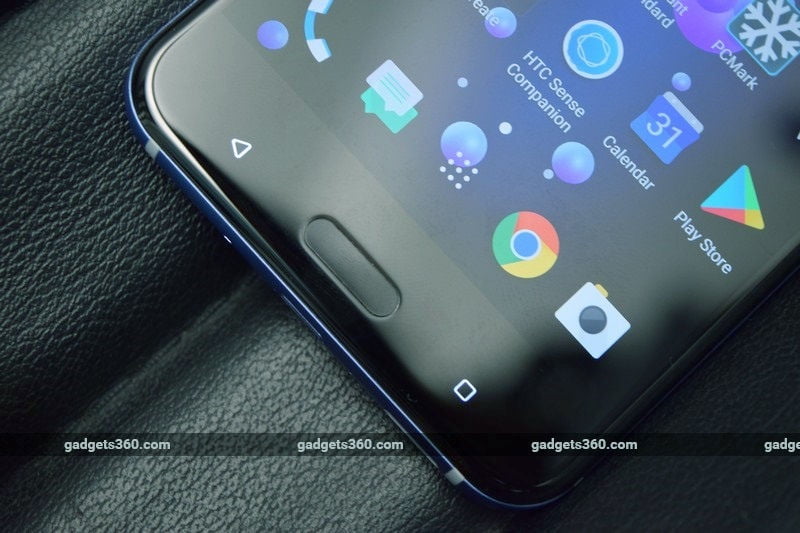
HIGHLIGHTS
- The HTC U11 competes with the Samsung Galaxy S8 and OnePlus 5
- You can squeeze the phone to launch the camera and quickly take a photo
- Gadgets 360 rates the HTC U11 9 out of 10
When we reviewed the HTC U Ultra just over three months ago, we said that it felt like a stopgap device, used to fill space before a true 2017 flagship could be launched and grab at least a little bit of the attention its competitors were getting. It seemed obvious that HTC was waiting for a supply of Qualcomm’s hot new Snapdragon 835 processor, and so we advised anyone interested in the HTC U Ultra for its looks to hang on for a little while before spending Rs. 60,000. As it turns out, we were exactly right. The HTC U11is already here and not only is it a lot more powerful than the U Ultra, but it also costs less.
With a launch price of Rs. 51,990, the HTC U11 is significantly more appealing than the U Ultra was at Rs. 59,990. It’s also got HTC’s brand new “squeezable” Edge Sense feature to set it apart. One big thing that the U11 lacks compared to the U Ultra is its secondary screen. However, this makes it slightly smaller, which a lot of people would, in fact, consider a good thing. With all of this to consider, we spent some time with the brand new U11 to figure out whether HTC has managed to get it right in round two.
HTC U11 design
Even if we didn’t totally love the colour of the U Ultra unit we got, we liked the fact that HTC had done something completely new and different with its design. Our U11 review unit has exactly the same ultra-glossy rear, but in an even lighter and brighter shade of blue (which for some reason is called Amazing Silver). HTC says that it has developed a new way to bond layers of glass with “highly refractive precious minerals”, which gives the material its metallic liquid look. It can also look very different under different types of light. The metal band around the sides is a slightly duller shade of blue, which makes the rear really pop. There’s also a Brilliant Black version, but this is the one you’ll want if you like showing off.
The finish of the rear is extraordinarily shiny and reflective, which means that every little smudge and fingerprint will be on display. The U11 might look great in a showroom, but there is literally no way to handle it without smudging the rear. Even if you wipe it all the time, you cannot avoid messing it up again, so it’s never really going to look as good as it does when you first lay eyes on it. HTC does throw a clear plastic case in with the retail package, but having it on makes the phone feel cheaper.
The front of the HTC U11 is a lot more conventional, with just a black face and the now-obligatory 2.5D curved-edge glass. Unlike its competitors, HTC hasn’t gotten rid of side borders for its flagship and, in fact, says that this is a good thing because otherwise screen content would be cropped or distorted at the edges – which is true. You can see the front camera and earpiece above the screen, but it would be easy to miss the narrow fingerprint sensor below it. The sensor doubles as a capacitive Home button, and you have the Back and Overview buttons on either side which light up when they’re touched.
The power and volume buttons are within easy reach on the right, and the left side is completely bare. What you can’t see are the “squeezable” Edge Sense zones which are on either side of the lower half of the phone. There’s a hybrid dual-SIM tray at the top and a Type-C port at the bottom. Also at the bottom is a single open slot instead of the usual speaker grille. Rather than having two stereo speakers, HTC has decided to go with the earpiece doubling as a tweeter with a separate woofer at the bottom. We’re going to test the efficacy of this design for ourselves, but we’re concerned about dust and lint collecting over time. Oh, and you won’t find a 3.5mm audio socket anywhere.

There’s only a single camera at the back, which sets the U11 apart from the majority of its competitors this generation. The camera protrudes just a tiny bit, but we didn’t mind that as much as the extremely prominent regulatory text lower down. We noticed the lack of a laser autofocus sensor, which the U Ultra does have. On the other hand, the U11 boasts an IP67 rating for water and dust resistance, while the U Ultra has no rating at all.
We criticised the U Ultra for being so slippery that we were constantly anxious about it falling out of our hands and pockets, and we’re quite relieved to find that HTC seems to have fixed this problem completely with the U11. The newer model is also a much more comfortable size and has curves in all the right places, making it very easy to hold and use even with one hand. Construction quality seems absolutely top-notch too.
HTC U11 specifications and software
Qualcomm’s flagship Snapdragon 835 processor is one of the main reasons for the U11’s existence. This is an octa-core CPU running at up to 2.45GHz, with an integrated Adreno 540 GPU and several hardware-level improvements targeted at everything from camera image processing to machine learning and sensors. You get 6GB of RAM and 128GB of storage, both of which are healthy amounts. A version with 4GB and 64GB respectively is available in some countries but hasn’t been launched in India, for now at least.
The 5.5-inch screen on the U11 is what HTC calls “Super LCD 5”, and has a resolution of 1440×2560. There’s a 3000mAh battery and pretty much every connectivity option you can think of, including dual-band Wi-Fi 802.11ac, Bluetooth 4.2, NFC, GPS with GLONASS, and of course 4G with VoLTE support. The USB Type-C port supports 5Gbps transfer speeds and DisplayPort video output. The HTC U11 can take two Nano-SIMs, with the second space doubling as a microSD card slot.
Despite a higher version number, the HTC Sense skin running on top of Android 7.1 feels exactly the same as what we saw on the U Ultra. It’s still fairly versatile, but not the best looking. HTC had announced its Sense Companion AI assistant with much fanfare when the U Ultra launched, and it wasn’t even close to fully baked at the time of the U Ultra’s launch. We found its functions largely pointless, and the promised voice response features were simply missing. Evidently, it still isn’t ready for primetime, and we didn’t find any of its barebones features helpful all during our review period. Perhaps it takes longer than a week to learn a user’s routine, but even then, it’s hard to get excited about weather updates, step counts, and lists of nearby restaurants.
The Blinkfeed screen, to the left of the main home screen, is supposed to show news updates but only has ads for HTC’s themes and third-party apps. You have to dig into the settings and enable News Republic and your assorted social media accounts as sources, which seems totally unnecessary. There are also loads of preinstalled apps. You can’t get rid of most of them including TouchPal keyboard, Facebook Messenger, and News Republic – though oddly you can uninstall HTC’s own Viveport and Zoe apps.

HTC sends popup notifications for “offers, contests and news by HTC and its partners”, but there’s a checkbox you can clear in the launcher settings menu. The app drawer scrolls vertically and page by page, which can be annoying. The default keyboard is called Sangam IME and while it looks a little crude, it offers local-language suggestions and spellcheck which might be useful to people in India. The default language is Indian English, and so you won’t be able to use Google Assistant unless you change to US English.
HTC U11 Edge Sense
There are a few gestures you can use navigate around Android and unlock the phone, but of course the real innovation here is Edge Sense. It’s off by default to prevent confusion, but you’ll see hints urging you to set it up and learn how it works. All you have to do is squeeze gently while the phone is in your hands, and you can trigger an action such as launching the camera or voice recorder, triggering the flashlight, or beginning voice-to-text transcription. If you enable “advanced mode”, you can set different triggers for short, regular and long squeezes. If you choose either the camera or voice recorder triggers, a second squeeze will begin recording.
You’ll see blue arcs appear on either side of the screen when you are pressing inwards, and a short vibration tells you that the squeeze has been registered – you can turn the visual feedback off once you’re comfortable with Edge Sense. At setup time, you’ll be able to calibrate the sensors to your grip strength.
While it might sound gimmicky, we actually found ourselves squeezing to launch the camera all the time – it’s surprisingly easy to get used to and it just makes a lot of sense. It also helps that this works when the camera is in standby, which means that you can take photos really quickly. Squeezing is a lot more fluid than double-tapping or hitting a button to wake the phone and then swiping. The only downside is that you can’t specify that you want to capture a photo or a video; the app will trigger whichever mode you were in last.
Of course your choices of hard cases will be limited if you want to use HTC U11’s Edge Sense feature, but we forsee plenty of options with flexible sides becoming available for the U11 and future models. This is a feature that could really become popular, and we hope HTC takes this idea and runs with it.

HTC U11 cameras
While most flagships (and for that matter, plenty of non-flagships) now have dual rear cameras, HTC seems content to stick to one. This is surprising considering that HTC was one of the early pioneers of dual cameras with the HTC One (M8). You don’t get an extra zoom or wide-angle lens, depth sensing, or detail enhancement, but HTC is claiming that this is the best ever smartphone camera even without extra hardware, and this is backed up by DxOMark, a highly regarded camera test firm.
There’s a lot going on to make that happen. The main camera has only a 12-megapixel sensor, but can go down to f/1.7. The U11 uses every pixel on its sensor to detect focus quickly, and can also deliver rapid HDR shots with an increased range between shadows and highlights. HTC says that this also comes into play with video – a technique called temporal noise reduction uses information from each frame’s preceding and following frames to clear up noise and improve detail. Low-light sensitivity is a particular strength, and there’s both optical and electronic image stabilisation.
HTC’s camera app looks relatively bare-bones, with only a few buttons and no sheets of options that pop up when you swipe in any direction. There’s a single menu with a row of icons for various modes, and depending on which one you’re in, you’ll see options right below that. It’s only if you switch to Pro mode that you’ll see more controls, including the option to save RAW data, and sliders for white balance, ISO, shutter speed, and focus. There are even presets – Night, Action, and Macro – which give you optimal combinations of those variables to suit each situation. There aren’t any filters, stickers or fun effects, but third-party apps almost always do that kind of thing better anyway.
When it comes to photo quality, we have to agree with HTC – this is one of the best smartphone cameras we’ve ever used. It delivers truly surprising quality in all kinds of situations, especially low light. The sample shots we took were universally excellent, with crisp focus and great details. We didn’t have any trouble with over- or under- exposure, compression, or colour accuracy. Macros are stunning, but the thing that really blew us away was low-light performance.
The HTC U11 managed to take bright, colour-rich shots in conditions that seemed impossible – most other phones would only produce greyish blurs. These shots were not entirely without noise or blur thanks to longer exposures, but even the slightest amount of incidental light on a small part of the framed subject was enough to result in a usable shot.
The 16-megapixel front camera benefits from many of the same features, and delivers excellent shots as well. The video recording resolution goes up to 4K in regular mode and 1080p at 120fps in Slow Motion mode. “Acoustic focus” uses the phone’s four microphones to isolate subjects from background noise. Motion is smooth, and videos were just as impressive as stills overall.
If there’s anything negative to be said about the U11’s camera, it’s that there isn’t as much creative control as there is with some dual-lens implementations – optical zoom would have been the perfect addition. The app was also sometimes too eager to take bursts when we didn’t necessarily want them – but this worked out to our advantage in some cases, such as trying to get a steady shot of a moving subject at night.



 Tap to see full-sized HTC U11 sample photos
Tap to see full-sized HTC U11 sample photos
HTC U11 performance and battery life
We had a lot of fun using the U11, especially because of its screen, cameras and speakers. HTC must have realised it was pointless to try and deliver stereo sound with asymmetrical speakers, and so having an independent woofer instead works much better. Sound is surprisingly loud, rich, and clear. It works brilliantly for games and movies, and various types of music are also handled quite nicely. The U11 comes with the same noise cancelling Type-C Usonic headset that we first encountered with the U Ultra.
The display is sharp and bright, and perfectly usable in all conditions and at all angles. HTC is correct about videos not being compromised by curved display edges, but the 2.5D glass front is still highly reflective. We did notice that the mid-rear of the phone got warm after even short amounts of casual use, but not enough to be uncomfortable.
Benchmark tests showed excellent results. We saw 181,626 points in AnTuTu; 1,908 and 6,581 in Geekbench’s single- and multi-core tests; 142.97 in Basemark Web; 39,962 points in 3DMark Ice Storm Unlimited; and 19fps in GFXBench’s Manhattan test at the native QHD resolution. Benchmark performance in most cases was equal to or better than that of the Samsung Galaxy S8 and S8+, and at par with the OnePlus 5.
Battery life is pretty good, and we were happy with the amount of usage we were able to get out of a full charge. You should be able to get through a full day with some audio/ video streaming, photography, and gaming thrown in. Our HD video loop test ran for 10 hours, 7 minutes which is just about the bare minimum we now expect from phones of this calibre.
Verdict
If we had paid the full launch price for an HTC U Ultra less than four months before the HTC U11, we’d be extremely put off with the company right now. The U Ultra is utterly and completely outclassed by the U11. We don’t miss the secondary screen at all, and almost all of our concerns and complaints about it have been addressed with this new model. This is the phone that HTC needed to launch in February or March, and we don’t see the point in alienating customers this way.
That said, even on its own, the U11 is a top-notch smartphone. It doesn’t have dual cameras or other tricks, and it doesn’t have the taller screens that its main competitors are now offering, but it’s gorgeous and powerful, with a camera that can deliver miracles in low light. Edge Sense quickly becomes second nature, and the Snapdragon 835 has plenty of headroom for demanding apps over the next few years. The chief disappointments are the non-starter Sense Companion UI and pedestrian battery life.
This phone is a serious contender, and it’s nice to see HTC at the top of its game again. The U11 goes up against the Samsung Galaxy S8 series and OnePlus 5, all of which have at least one standout USP. Your choice comes down to whether your top priority is taking incredible photos, looking great, or saving some money.
For the latest tech news and reviews, follow Gadgets 360 on Twitter, Facebook, and subscribe to our YouTube channel.

HTC U11
- REVIEW
- KEY SPECS
- NEWS
- Design
- Display
- Software
- Performance
- Battery life
- Camera
- Value for money
- Good
- Stunning low-light camera performance
- Looks great
- Water and dust resistant
- Useful “Edge Sense” squeeze gesture
- Top-tier specifications
- Bad
- Average battery life
- Sense Companion not ready yet
-
HTC U11 (Amazing Silver, 128GB, 6GB RAM) –Rs. 51,990
-
HTC U11 (Brilliant Black, 128GB, 6GB RAM) –Rs. 51,990
[“Source-gadgets.ndtv”]










